In addition to cheese, trains and museums, Europeans tend to look down on another aspect of North American life: The way we dress on a bike.
Cases in point. This image is from my city of Calgary.
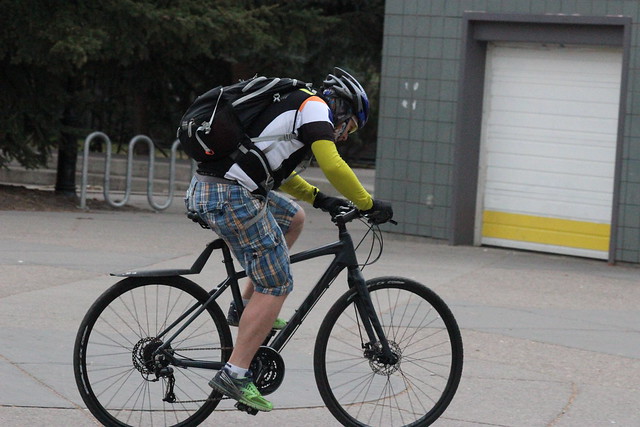
This one from the Netherlands.
Calgary.
Netherlands
See the difference? I’m not judging their fashion choices (good lord, have you see my wardrobe?). I’m pointing out how North Americans tend to gear up for athletics, while Europeans gear up for the cafe.
But as our cities grow more bike friendly, I’m seeing more and more casual cyclists who are following the mantra of former Calgarian Mikael Colville-Andersen of Copenhagenize and dressing for the destination, rather than the journey.
Still,the default North American bicycle commuter isn’t exactly haute couture. Rather, what I’m seeing is more people finding a middle ground between full MAMIL diaper shorts and Coachella street style. Let’s call it transitional cyclist casual.
Case in point.
See what I mean? She is still rocking that quick-dry reflective MEC jacket that is nearly de rigueur for commuter cyclists in my neighbourhood, but has at least made some accommodation to fashion on the lower half. She could walk into a downtown coffee shop, strip that jacket and not feel at all out of place.
A step further. This dude could park his bike, eat dinner, go for a drink at the pub and not stand out, even though he’s still made a few accommodations for the bike, including the backpack and the helmet.
This isn’t about anyone’s sense of style, or lack thereof , I’m just pointing out that stylistic choices among the commuter set seem to be changing, in so far that style does seem to be emerging as an actual choice.
Perhaps this is the transition period, a unique North American interpretation that strives for the dress-for-the-destination aspiration, while remaining rooted in the realities of bike transportation in cities that don’t make it very easy to ride a bike for transportation.
So there you go: North American Transitional Cycling Couture.
Until we see more people like this. From Calgary, not Copenhagen. Seriously.

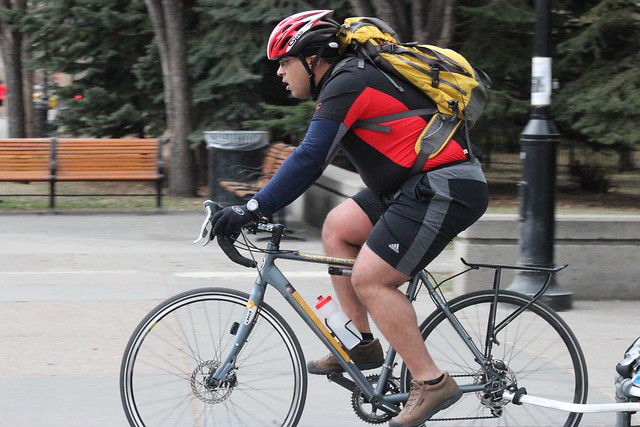
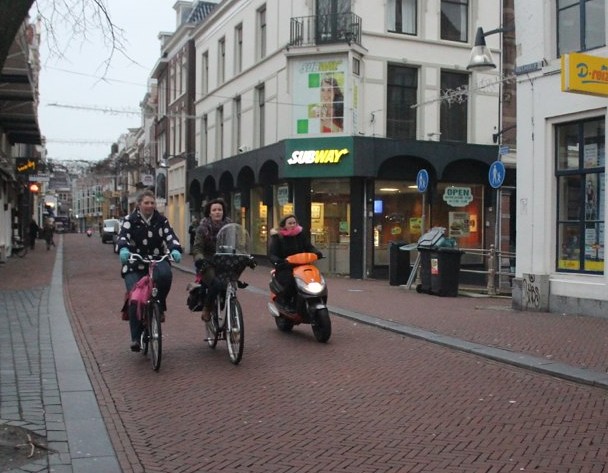

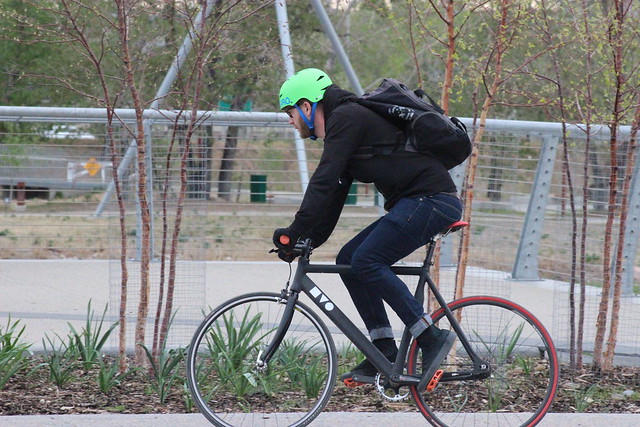
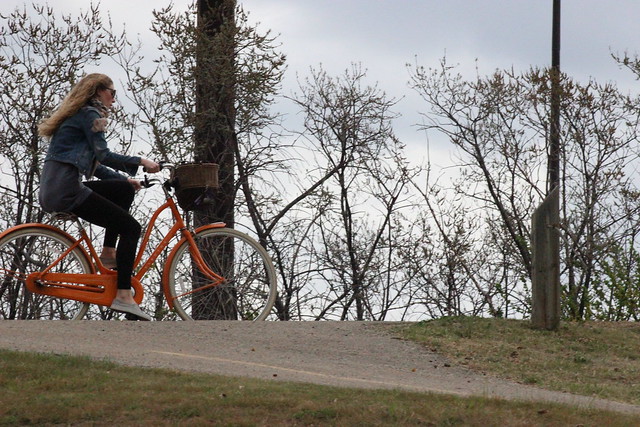
Thoughts on helmets? I feel naked w/o mine, but if I was riding off the main arteries and just to the store or pub I could get used to not wearing one. Maybe.
I’m not a helmet fundamentalist. If I’m riding in heavy traffic, or on a fast ride through busy streets, I’ll wear one. But if I’m riding through the neighbourhood to the grocery store on quiet roads, I’ll skip it. I don’t think there’s any need to be pro- or anti-helmet strictly. There’s grey area, especially in North America where we don’t have safe infrastructure.
Great article on evolving cycle chic in Calgary. Also starting to see evolution of bikes.
A few related thoughts: Inner city Calgary riders don’t all need 27 gears and super light weight bikes. This culture is great for bike shops, but feeds the spandex, helmet clad, higher speed cycling that has dominated Calgary in the past. Slower, cheaper bikes are all that most people need. It is a bit like the high number of 4×4 vehicles in Alberta, when most people never go off road. Also, expensive bikes tend to result in more bike theft.
As I get older I don’t like to climb over that bar and a high bike seat every time I start and stop my trip. Step thru bikes are looking more attractive every year!
Just back from China and Japan and saw over 100,000 cyclists in a dozen cities. Only a handful had expensive bikes, helmets or spandex and almost all had step thru bikes and no high bar to deal with. Bike share was in every city and all bike share bikes had step thru bike design. Will be interesting to see the evolution of cyclists, bikes and clothing in Calgary.
Another idea for a blog is the relationship between expensive ($1,000+?) bikes and bike theft. Many cities have less bike theft because bikes are much cheaper and not profitable for thieves.
Just a few thoughts…. Congrats on the new direction!
All great points, Don. That’s an interesting thought that worse bikes may lead to lower levels of theft, and something I will definitely look into. I know in some cities, bike theft is so common that losing a bike is almost just part of daily life, which also leads to lower-quality bikes because nobody wants to invest any money in it. In the Netherlands, for example, some people have different bikes just sitting at train stations all over the country. If it gets lost, well, just replace it.
Thanks for sharing.
Apparently this device is pretty effective for deterring bike theft (and comical).
http://cnews.canoe.com/CNEWS/WeirdNews/2016/01/15/22593627.html
I think what fundamentally separates us is attitudes, not clothes. Most people in cities with a “bike culture” treat cycling as the most efficient means to get from Point A to Point B. Cycling largely stayed alive in North America as a sporting or recreational activity, hence the eye burning sightings of MAMILs.
That being said, I believe there is a good reason why we often wear some form of athletic clothing while biking: our summers are much warmer. Copenhagen has average highs in the summer months of 20 degrees, whereas Ottawa has an average high of about 25. In the early Spring/Fall/Winter, street clothes work fine, but with a humidex driving things above 30, you’re not going to be winning popularity contests at work if you wear the same dress shirt you biked in!
This may be the first time we’ve heard the argument that cycling in Canada is difficult because it’s too warm! But this is a good point. Avoiding sweat on a bike is a problem, not just in summer — it can also be difficult to ride in winter without sweating because it requires so many layers to keep warm during the the slow moments. This is why it’s counter-productive to insist we all dress like Europeans on a bike, and to discourage things like workplace showers. It’s nice to have options.
Thanks for the comment. Great insight.
I’ve noticed that how I dress is heavily influenced by how far I have to go: 5K = jeans/regular looking clothes. 10+K = more breatheable/athletic/layers that can be shed (if I’m going to a meeting or the like). I have to wonder how much distance plays a role into the differences in cycling culture between here and Europe – we’re so sprawled out in North America, it makes it a trek to get anywhere by bike.
Oh, It’s also cultural. There is practically no climate or weather difference between Ottawa and Montréal, and I see lots of “civilised” looking cyclists here. What is so hard about carrying an extra top to your workplace; summer clothes don’t take up much space. I do wear something akin to lycra running or gym shorts under my skirt, but unless I’m actually touring, which I haven’t done in a long time, they are certainly not visible.